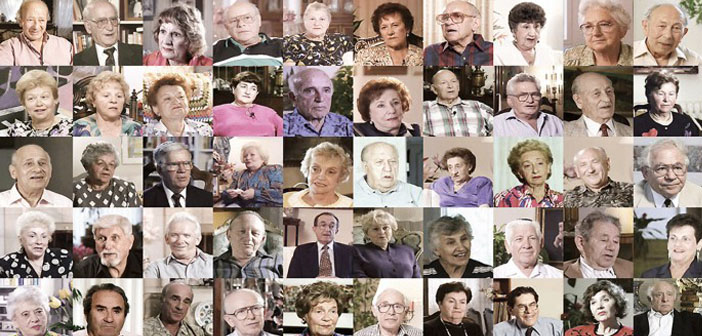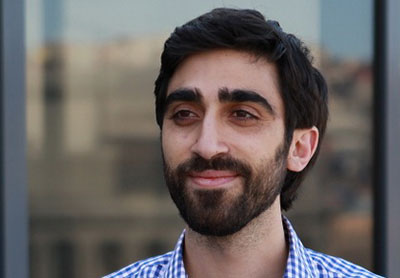Shoah Vakfı’nın Soykırım koleksiyonu erişime açıldı


Kaliforniya’daki Shoah Vakfı’nın elindeki Ermeni Soykırımı tanıklıkları indekslenip, vakfın görsel tarih arşivine eklendi. Hamidiye Katliamları’ndan Adana Katliamı’na, Musa Dağ İsyanı’ndan Van Direnişi’ne kadar pek çok olaya dair tanıklıkları içeren toplam 400 film, ücretsiz olarak kamunun erişimine açıldı. Kısa süre önce bir dijital kütüphane platformuyla yapılan anlaşma çerçevesinde, yakında üniversitelerden erişilebilecek olan koleksiyonu, projeyi yürüten Manuk Avedikyan’la konuştuk.
Shoah Vakfı’nda Ermeni Soykırımı’na dair nasıl bir çalışma yapılıyor? Vakfın, soykırım ve insanlığa karşı suçlara dair, dünyadaki en büyük arşive sahip olduğu söyleniyor...
Görsel Tarih Arşivi’nde (GTA), tüm tanıklıklar indeksleme etiketleriyle sunuluyor. Shoah Vakfı, Holokost tanıklıkları içeren 52 bin mülakatı indeksledikten sonra, çalışmalarını insanlığa karşı diğer suçları da kapsayacak şekilde genişletti. Bu çerçevede, Ruanda ve Nankin’e gidip mülakatlar yaptık, başka koleksiyonları da arşivimize kattık. Yahudi Aile ve Çocuk Servisi’nin Holokost’la ilgili mülakatları ve benzer şekilde Ruanda’daki Kigali Soykırım Anıtı ve Guatemala’daki bir organizasyonun yaptığı kayıtlar önümüzdeki aylarda halka açılacak. Ermeni Film Vakfı’nın çalışmaları da aynı kategoride değerlendiriliyor. Ben projeye indeksçi olarak dahil oldum, ilerleyen safhalarda proje koordinatörü olarak devam ettim.
Ermeni Soykırımı tanıklıklarından oluşan koleksiyondan bahseder misiniz?
Ermeni Film Vakfı’nın arşivimize giren çalışması bir belgesel film niteliğinde. Ancak bu, metodolojik bir sözlü tarih çalışması değil. Vakfın bu işi, Ermeni Soykırımı’yla ilgili, ‘Görsel Tarih Arşivi’ne giren ilk koleksiyon. Arşivimizdeki bu soykırım tanıklıkları, GTA’nın merkezinde ya da dünya genelinde arşivimize tam erişimi olan 55, kısmi erişimi olan 213 birim üzerinden izlenebiliyor. Bunlar için üyelik ücreti talep edilmiyor. GTA’nın çevrimiçi versiyonu herkese açık ama burada arşivdeki videoların sadece kısa versiyonları bulunuyor. Shoah Vakfı kısa süre önce dijital kütüphane platformu ProQuest’le bir anlaşma yaptı; çok yakında, GTA’ya pek çok üniversiteden erişim sağlanabilecek.

Arşivinizdeki Ermeni Soykırımı tanıklıklarına bakanlar nelerle karşılaşacak?
Ermeni Film Vakfı’nın yöneticisi Michael Hagop-ian ve ekibi, 1972-2013 yılları arasında Avustralya, Kanada, Ermenistan, Suriye, Lübnan, Yunanistan, Almanya, İngiltere ve Fransa gibi ülkelerde birçok kayıt yapmış. Ancak, konuşulanların çoğu, Ermeni Soykırımı’ndan kurtulmuş, şu an Amerika’nın çeşitli yerlerinde ikamet eden insanlar.
Arşivde, Soykırım’dan kurtulanların yanı sıra, misyonerler, misyonerlerin aile üyeleri veya diplomatlar gibi yabancı tanıklarla; çoğunlukla Der Zor ve Kamışlı’dan, sürgün Ermenilere yardım etmiş Araplarla; Ermenistan’daki Ezidi tanıklarla; İzmir yangınından kurtulan Rumlar ve mübadillerle; Taner Akçam, Hilmar Kaiser, Richard Hovannisian, Raymond Kevorkian gibi tarihçilerle; Kafkas Cephesi’ndeki veya Fransız lejyonundaki Ermeni fedailer ya da gönüllü milislerle; Musa Dağ’daki direnişten sağ çıkanlarla; Suriye’deki İslamlaşmış Ermeni ailelerle; 1970’lerde Amerikalıların Ermeni Soykırımı’na bakışını yansıtmak açısından Soykırım’da hayatta kalanların Amerika’daki yakınlarıyla; Soykırım’dan kurtulanlarla yapılmış mülakatlar bulunuyor. Bu arşivde, 1894-1896 Hamidiye Katliamları’ndan kurtulup 1915’ten önce Amerika’ya göçenlerin, bu katliamlardan sonra Ermeni Soykırımı’nı yaşayıp ondan da kurtulabilenlerin tanıklıklarını da izleyebilirsiniz. Hagopian’ın ‘Almanya ve Gizli Soykırım’ adlı filminde, Almanya’nın Ermeni Soykırımı’ndaki sorumluluğu hakkında konuşan tarihçiler var.
Bunun Ermeni Soykırımı tanıklıkları alanındaki en büyük arşiv olduğu doğru mu?
Ermeni Film Vakfı’nın koleksiyonu en geniş Ermeni Soykırımı ‘film’ koleksiyonu. Diğer koleksiyonlar bu kadar çok sayıda 16 mm film içermiyor. Fakat daha geniş arşivler var; örneğin Zoryan Enstitüsü’nün yaklaşık 800 videoya ulaşan koleksiyonu... Richard Hovannisian’ın UCLA Ermeni Soykırımı Sözlü Tarih Projesi’nde de 800 tanıklık yer alıyor ama bunlar görüntü değil, ses dosyaları. Dünyanın farklı yerlerinde daha küçük koleksiyonlar da bulunuyor. Bizde kayda alınmış yaklaşık 400 tanıklık var ama 334 profil veriyoruz, çünkü Hagopian çekim aşamasında 20’den fazla grup mülakatı yapmış.
Siz nasıl bir indeksleme yaptınız?
İndeksleme, Shoah Vakfı’nda yaptığımız işin en önemli parçalarından biri. Bunu görüntülü tanıklıkların yer aldığı bir kitabın arkasındaki indeks bölümü gibi kabul edebilirsiniz. Bu çalışmaya, Steven Spielberg’in girişimiyle toplanan 52 bin orijinal Holokost tanıklığı kaydıyla başlanmıştı. Tanıklıkları indekslerken, kayıtları inceleyen araştırmacılar veya diğer insanlar, tanıklıklar içinde hangi konunun ne zaman gündeme geldiği bilgisine kolayca ulaşabilsin diye ‘çalmak’, ‘toplu infaz’, ‘Adana Katliamı (1909)’ ya da ‘Van (Türkiye)’ gibi dizin etiketleri kullanıyoruz.
İndeksleme aşamasında çalıştığınız konuya dair yeni şeyler öğrendiğiniz mi? Sizin için bir sonraki adım ne olacak?
Çok şey öğrendim. 200’e yakın tanıklığı kendim indeksledim, diğerlerininse kontrollerini yaptım. Tanıklıklarda adı geçen onca köy ismini kaydetmek bir macera oldu benim için – özellikle de bunların nerede olduğuna dair elimizde çok az ipucu varken... Asgari düzeyde de olsa Türkçe bilmek, bu köylerin coğrafi konumlarını ararken çok işime yardı. Sevan Nişanyan’ın haritasından da faydalandım. Demiryolu boyunca kurulan tehcir kamplarının işlevi konusunda çok şey öğrendim. Bu koleksiyonda geçen lehçelerinin sayısının çok yüksek olduğunu da eklemeliyim. Burada Batı Ermenicesinin lehçelerini tüm çeşitliliğiyle görebilirsiniz. Soykırım ve standartlaşmış dil eğitimi nedeniyle yok olmanın eşiğine gelen Batı Ermenicesinin farklı lehçelerin bu koleksiyonda muhafaza ediliyor. Mülakatlar şu anda Ermeniceden İngilizceye tercüme ediliyor. Türkçe, Arapça, Rumca ve Kürtçe dillerinde yapılan mülakatlar da tercüme edilerek, İngilizce altyazılar hazırlanacak.


